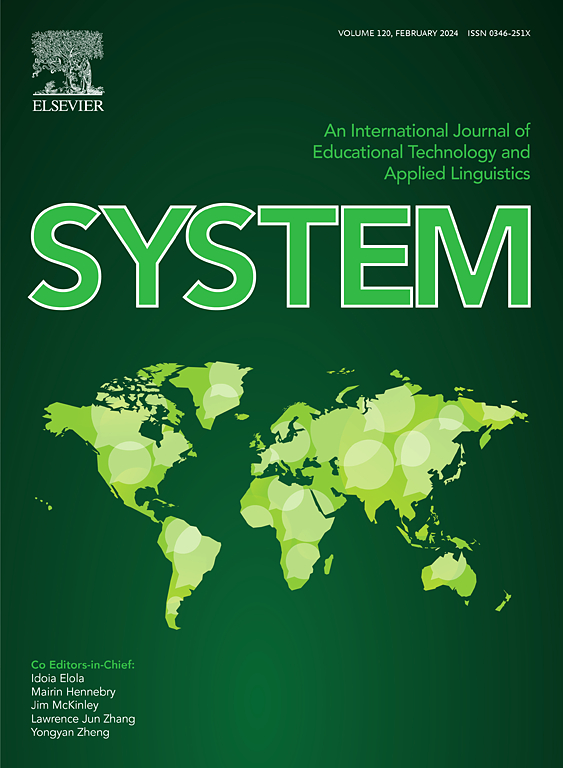超越语言:情态偏好、非语言敏感性和视觉动态丰富性在二语听力中的作用
IF 5.6
1区 文学
Q1 EDUCATION & EDUCATIONAL RESEARCH
引用次数: 0
摘要
本研究探讨感官偏好如何影响第二语言学习者在视觉强化听力任务中的理解。基于对面对面交流本质上是多模态的理解,我们研究了非语言视觉线索(如手势和面部表情)如何与学习者特征相互作用以形成理解。采用感官偏好测试(SPT)对160名英语学习者进行了情态偏好(听觉或文本)和非语言视觉敏感性(NV)的分类。他们在四种条件下完成托福式的听力任务:纯音频、照片、关键帧和视频。方差分析和回归分析表明,视频提供了动态和连续的视觉输入,似乎提供了最广泛的支持,特别是对于具有高NV敏感性的学习者。相比之下,关键帧和静态图像产生了混合效果:关键帧支持听觉nv敏感的学习者,但阻碍了文本nv敏感的学习者,而照片提供了一致性,但总体上的好处有限。基准听力能力和NV敏感度——特别是在与输入格式的交互中——成为理解的重要预测因素,强调了早期适应视觉输入如何塑造稳定的表现。这些发现强调了教学脚手架的必要性,它可以帮助学习者在视觉格式上建立灵活性,而不是根据个人偏好量身定制标准化评估。非语言线索整合和多模态意识的针对性训练可以增强学习者的适应能力,使他们更好地为现实世界中视觉输入的可变性做好准备。本文章由计算机程序翻译,如有差异,请以英文原文为准。
Seeing beyond the words: Modality preferences, nonverbal sensitivity, and the role of visual dynamic richness in L2 listening
This study investigates how sensory preferences affect second-language (L2) learners' comprehension during visually enhanced listening tasks. Building on the understanding that face-to-face communication is inherently multimodal, we examined how nonverbal visual cues—such as gestures and facial expressions—interact with learner traits to shape comprehension. A total of 160 EFL learners were classified by modality preference (auditory or textual) and nonverbal visual sensitivity (NV), using a validated Sensory Preference Test (SPT). They completed TOEFL-style listening tasks presented under four conditions: audio-only, photo, keyframe, and video. ANOVA and regression analyses indicated that video, offering dynamic and continuous visual input, appeared to provide the broadest support, particularly for learners with high NV sensitivity. In contrast, keyframes and static images yielded mixed effects: keyframes supported auditory NV-sensitive learners but hindered textual NV-sensitive learners, while photos provided consistency but limited benefits overall. Baseline listening ability and NV sensitivity—especially in interaction with input format—emerged as significant predictors of comprehension, underscoring how early adaptation to visual input can shape stabilized performance. These findings highlight the need for instructional scaffolding that builds learners' flexibility across visual formats, rather than tailoring standardized assessments to individual preferences. Targeted training in nonverbal cue integration and multimodal awareness may enhance learners’ adaptability, better preparing them for the variability of visual input in real-world communication.
求助全文
通过发布文献求助,成功后即可免费获取论文全文。
去求助
来源期刊

System
Multiple-
CiteScore
8.80
自引率
8.30%
发文量
202
审稿时长
64 days
期刊介绍:
This international journal is devoted to the applications of educational technology and applied linguistics to problems of foreign language teaching and learning. Attention is paid to all languages and to problems associated with the study and teaching of English as a second or foreign language. The journal serves as a vehicle of expression for colleagues in developing countries. System prefers its contributors to provide articles which have a sound theoretical base with a visible practical application which can be generalized. The review section may take up works of a more theoretical nature to broaden the background.
 求助内容:
求助内容: 应助结果提醒方式:
应助结果提醒方式:


